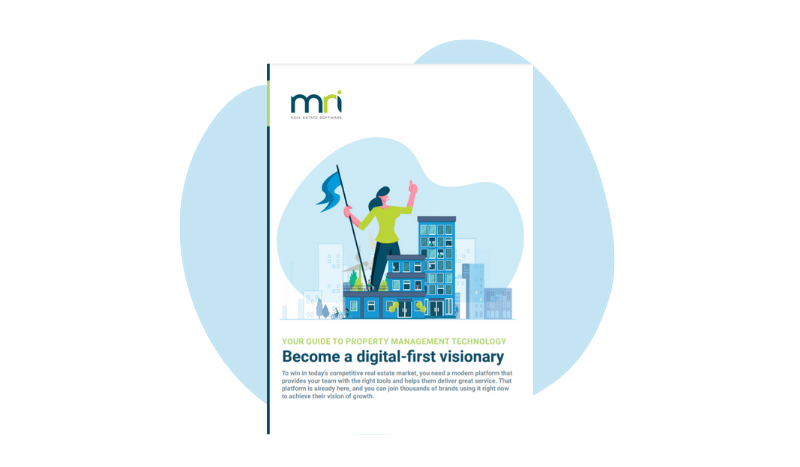How to prepare a business continuity plan for natural disasters
Natural disasters don’t just disrupt operations, they can derail your business if you’re not prepared. As a landlord or property manager, you need a clear plan to protect your assets, tenants, and team. This guide will show you how to create a practical natural disaster business continuity plan that works when you need it most.
Table of contents:
- The essentials of business continuity planning and disaster recovery
- Why a business continuity plan for natural disasters is essential
- Steps to develop a business continuity plan for natural disasters
- Testing and updating your plan
- Communicating the business continuity plan to employees and stakeholders
- FAQs
- Enhancing disaster resilience with MRI Software
Guide to Property Management Technology
Discover easy-to-use technology to set your business up for success.

The essentials of business continuity planning and disaster recovery
A good business continuity disaster recovery plan keeps your operations running during the worst situations, and you should also be aware of the difference between business continuity and disaster recovery. Think of it as a safety net: it minimises downtime, safeguards assets, and protects people. Here’s what makes these plans indispensable for landlords and property managers. what makes these plans indispensable for landlords and property managers.
What is business continuity planning?
Business continuity planning is about staying operational no matter what comes your way. It’s the process of identifying your essential functions and ensuring they keep running during emergencies. For example, if your office is flooded, your plan should address how to keep collecting rent, communicating with tenants, and maintaining essential building services.
The role of disaster recovery
Disaster recovery ensures that disruptions are temporary and that normal operations resume quickly. It includes restoring IT systems, repairing physical damage, and managing tenant needs. Key components of a disaster recovery plan for natural disasters include:
- Procedures for restoring water, power, and internet connectivity.
- Plans to repair damaged infrastructure and secure properties.
- Strategies for ensuring tenant needs are met during recovery.
Why a business continuity plan for natural disasters is essential
Natural disasters can strike without warning, causing significant financial and operational harm. If your properties aren’t prepared, the losses can be devastating. A natural disaster business continuity plan helps you face these challenges head-on, ensuring that you recover with minimal disruption.
Risks posed by natural disasters
Natural disasters such as hurricanes, wildfires, and earthquakes can disrupt property management significantly. Each disaster brings unique risks, such as structural damage, tenant displacement, or utility failures. To mitigate these risks, consider:
- Reinforcing buildings in hurricane-prone areas.
- Installing fire-resistant materials in wildfire zones.
- Using elevation and drainage improvements to prevent flood damage.
Specific challenges for businesses
Property managers face many logistical and financial hurdles during natural disasters. Communication breakdowns, tenant evacuations, and supply chain issues can compound the challenges. For example:
- How do you house tenants during prolonged repairs?
- What’s your plan for reaching tenants if communication networks fail?
- Can you access critical repair supplies during regional emergencies?
Steps to develop a business continuity plan for natural disasters
Creating a natural disaster business continuity plan involves detailed preparation, from assessing risks to ensuring IT recovery. Each step builds a foundation to help you minimise downtime and protect your properties. Follow the steps below to stay ahead of the storm.
Risk assessment and business impact analysis
Start by evaluating potential risks specific to your properties. Identify which disasters, like floods, hurricanes, or wildfires, are most likely in your area. Use these steps to conduct a risk assessment effectively:
- Review NEMA’s hazard maps to understand local risks.
- Assess your properties’ structural resilience to disasters.
- Calculate potential financial losses for each disaster scenario.
Create a response strategy
A well-thought-out response strategy is critical to keeping your operations on track during emergencies. This includes evacuation plans, communication protocols, and clear instructions for managing tenants’ safety. Key components of an effective response strategy include:
- A tenant communication plan, including email and text alerts.
- Clear evacuation routes and designated assembly points.
- Contact information for emergency services and contractors.
Data and IT recovery
Protecting digital assets is just as important as securing physical properties. Ensure your business-critical systems, like rent collection software, are backed up to the cloud. To ensure IT resilience, implement these practices:
- Use automated backup systems to protect tenant and financial data.
- Regularly test your ability to restore critical systems.
- Partner with IT providers that offer disaster recovery solutions.
Plan for alternate locations and resources
Have contingency plans for alternative workspaces and resources. This could include securing a coworking space or pre-arranging contracts with temporary housing providers for tenants. You should also maintain:
- Emergency kits with supplies like food, water, and flashlights.
- Backup generators for maintaining essential building systems.
- Pre-negotiated contracts with vendors for emergency services.
Testing and updating your plan
Your business continuity disaster recovery plan isn’t a one-and-done project. It requires regular testing and updates. This ensures that your plan remains effective as your properties, operations, and risks evolve.
Importance of regular testing
Conducting drills and simulations ensures your team is ready for any disaster. For example, schedule fire drills to test evacuation plans or simulate a flood scenario to evaluate tenant communication protocols. To make testing comprehensive, consider:
- Practicing full-team emergency response drills.
- Testing communication systems with tenants and staff.
- Running simulations for IT recovery and data restoration.
Continuous improvement
Natural disasters are unpredictable, and your plan should adapt to changing circumstances. Stay up to date on new technology, such as AI-based disaster prediction tools, which can provide early warnings for storms or floods. Regular updates to your business continuity disaster recovery plan should cover:
- Adjustments based on lessons learned from drills.
- New risks, such as emerging weather patterns or cyber threats.
- Integrating new tools or services for disaster preparedness.
Communicating the business continuity plan to employees and stakeholders
Clear communication can make or break your disaster response. When everyone understands the plan and their roles, your response becomes faster, smoother, and more effective. Your business continuity plan for natural disasters should always include a plan-of-action for communication.
Employee training
Regular training sessions ensure your team knows how to act during an emergency. For example, familiarise your staff with building evacuation plans by walking through the routes during safety drills. To enhance training efforts, you can:
- Use interactive workshops or online training modules.
- Provide printed guides with step-by-step emergency procedures.
- Schedule quarterly refresher sessions to reinforce knowledge.
Stakeholder communication
Tenants and stakeholders rely on you for timely updates during disasters. Share emergency preparedness guides, update them on recovery timelines, and provide key contact information. Tools like a visitor management system can simplify communication by tracking who is on-site and ensuring everyone receives critical updates.
FAQs
Enhancing disaster resilience with MRI Software
MRI Software offers tools that make business continuity planning easier and more effective. With our digital rent payment solutions, you can ensure rent collection continues uninterrupted, even during natural disasters. By automating processes and providing secure data systems, our software supports landlords in staying operational and safeguarding tenant trust during emergencies. Contact us today to learn more.
Snug announces partnership with MRI Software
Snug, an innovative provider of property management automation tools, announced that it has partnered with MRI Software, a global leader in real estate solutions and services. The partnership integrates Snug’s automation capabilities with MRI Propert…

